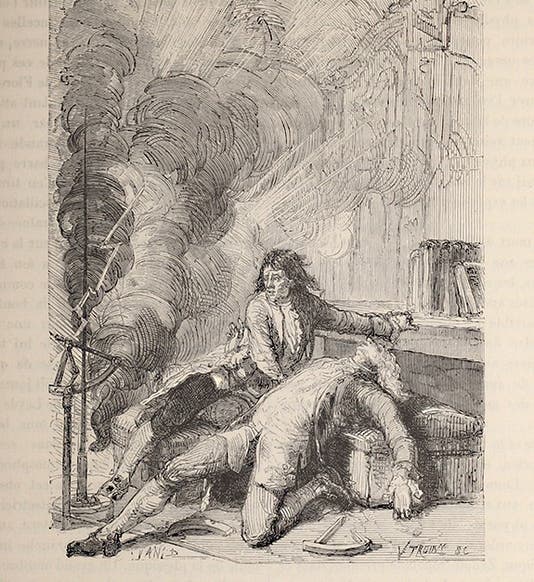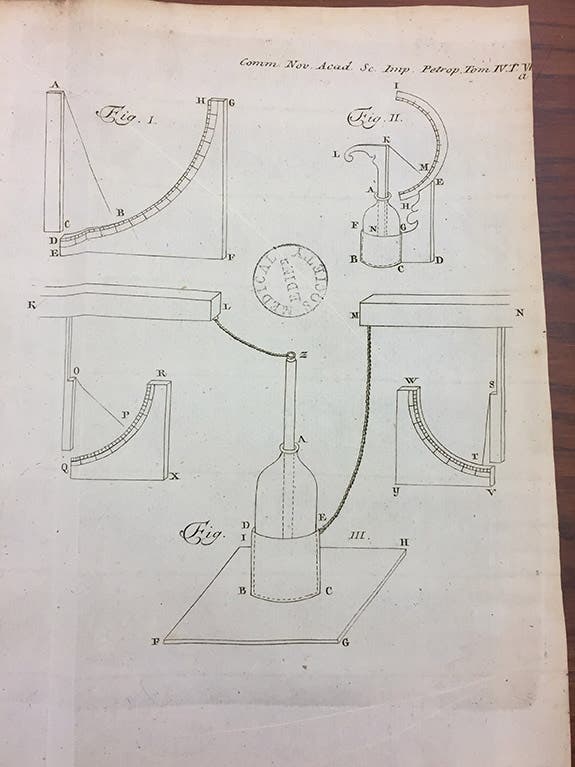Scientist of the Day - Georg Wilhelm Richmann
Georg Wilhelm Richmann, a Baltic German electrical investigator, was born July 22, 1711. His homeland was subsequently subsumed into the Russian Empire by Peter the Great (Peter I), and Richmann ended up in St. Petersburg, the city founded by Peter, and the seat of the Russian Academy of Sciences, also founded by Peter. Richmann eventually became professor of physics at the Academy and director of the physical cabinet. In the 1740s, electrical phenomena aroused the interest of nearly every physical scientist, especially after the accidental invention of the Leyden jar in 1745. Richmann threw himself into electrical pursuits and distinguished himself from many other investigators by his quest for precision, desiring instruments to measure the force of electrical attraction and repulsion. He invented one, a kind of electrometer, that he described and illustrated in a paper in the Novi commentarii of the Academy in 1752. It was known that a piece of thread or foil, attached at one point to an electrified object, will flare out from that object, and the greater the charge, the greater the angle of separation. Richmann found a way to fix a scale behind such a thread so that the angle could be accurately measured. In the engraving that accompanied his paper, the two electrometers below are attached to electrodes connected to a Leyden jar (second image).
Then in 1752, Benjamin Franklin in the American colonies asserted not only that lightning is an electrical phenomenon, but that an experiment could demonstrate the truth of his supposition. Insulate a "sentry-box," Franklin suggested, stick a metal rod up into a storm, and see if one could charge a Leyden jar from the clouds (indicating that lightning is electrical). The experiment was first done successfully at Marly-la-ville in France in May of 1752, as sparks were drawn from the rod. Richmann wanted to do this himself, so that he could use his electrometer to measure the force of atmospheric electricity, so he set up an iron rod in his house connected to a wire on the roof, with his electrometer mounted on the iron rod. On Aug. 6, 1753, a thunderstorm moved in, and he rushed home from the Academy, taking with him the Academy's engraver (presumably to record some images). The engraver ended up being a witness to a most historic event. As the storm gathered and Richmann had his eye on his electrometer, the engraver saw a small ball of lightning leap from the bar to Richmann’s forehead, sending him soundlessly to the floor. An explosion then scattered things around the room, and the engraver ran for help to fight the resulting fire, while Mrs. Richmann rushed in to find her husband not just stunned, as the engraver thought, but dead. Richmann was the first fatal victim of electrical investigation, and sentry-box experiments ceased immediately. The engraver did not do his job and record the event with his pencil or burin (at least so far as I know), so we must have recourse to the wood-engraving in Louis Figuier's Les merveilles de la science, some 115 years later (first image). Figuier also provided an illustration of the more successful sentry-box experiment in Marly, if you are interested.
Several weeks after the incident, a letter was written by someone at the Academy, announcing the circumstances of Richmann' s death, and eventually that letter was translated into English and published in the Pennsylvania Gazette for Mar. 5, 1754. You can read the complete letter here. The final paragraph of the publication is of interest because it bears the unmistakable stamp of Benjamin Franklin and seems to have been added by him. We quote the paragraph in full:
The new Doctrine of Lightning is, however, confirm’d by this unhappy Accident; and many Lives may hereafter be sav’d by the Practice it teaches. M. Richmann being about to make Experiments on the Matter of Lightning, had supported his Rod and Wires by Electrics per se, which cut off their Communication with the Earth; and himself standing too near where the Wire terminated, help’d with his Body to compleat that Communication. It is plain the Wire conducted the Lightning to him thro’ the whole Length of the Gallery: And had his Apparatus been intended for the Security of his House, and the Wire (as in that Case it ought to be) continued without Interruption from the Roof to the Earth, it seems more than probable that the Lightning would have follow’d the Wire, and that neither the House nor any of the Family would have been hurt by that unfortunate Stroke.
Franklin was quite right – the key to surviving lightning in the laboratory is to make sure that you are NOT connected to ground, and that your prime conductor IS. Richmann got it backwards, and it cost him his life.
Richmannn is moderately well appreciated by the Russian populace, even though he is little known in the West. This is probably because Richmann was well-liked and respected by Mikhail Lomonosov, and Russians revere Lomonosov more than any other early scientific figure. There is a monument with a bust of Richmann in his hometown of Pärnu, Estonia.
We would like to acknowledge John Heilbron's authoritative book, Electricity in the 17th and 18th Centuries (1979), for help in compiling this post.
Dr. William B. Ashworth, Jr., Consultant for the History of Science, Linda Hall Library and Associate Professor emeritus, Department of History, University of Missouri-Kansas City. Comments or corrections are welcome; please direct to ashworthw@umkc.edu.







